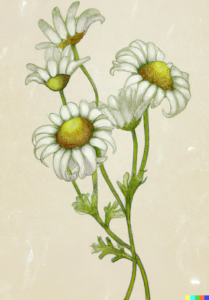Herb: Chamonilla recutita, Matricaria recutita

Chamomile by Kathy McCabe with AI assistance
Common Name: Chamomile (Chamomile, Mayflower)
Family: Asteraceae
Ayurvedic / TCM: Huang Chu Ju
Parts Used: Flowers, sometimes leaves
Native Region: Native to many countries in Europe
Geographic Distribution: Most all temperate climates.
Botanical Description: Perennial plant that grows (in my yard) to about 2 feet and has frequent blossoms in summer months that are white with yellow- button centers.
Harvesting Guidelines: Pluck the blossoms (leaving some for pollination) when fully open, or harvest unblemished adult leaves (not old, not young)
Constituents: Apigenin, Alpha-bisabolol, terpenoids, flavonoids, coumarins, herbiarin, volatile oils, caffeic acid, phenylpropanois
Uses:
Mild sedative, anti-inflammatory. Calms the nerves, settles the stomach, and helps expel gas. Chamomile is also useful for colds and flu in children when combined with elder flower, peppermint, and yarrow. (Easley/Horne, 2016) I have personal experience in using Chamomile as a pain remedy and for itching skin (dry skin). Chamomile calms the skin when incorporated into a lotion or oil and bathing in a ‘tea’ of chamomile and oatmeal is also extremely beneficial.
The brew of dried or fresh flowers is particularly useful as a febrifuge, and externally as a hair brightener. (de Baracli Levy, 1997) Irritability, restlessness, insomnia, indigestion, dyspepsia, gas, fever, colds, flu, teething, colic, and externally for burns, rashes, conjunctivitis. (de la Foret, 2017)
I was gratified to learn from Ms. de la Foret of Chamomile’s pain-relieving qualities. As a chronic pain patient of many years, I use large amounts of chamomile in my pain-relieving tea. Chamomile is also a staple ingredient in my salves for skin rashes.
Chamomile has been used for centuries, in the middle ages it was used for colds, fevers, inflammation and nausea. Egyptians offered the flowers to their Sun God Ra, and the Germans referred to the herb as ‘capable of anything’. (EWHA, 2015)
Cammomill is good against the collicke, it provoketh urine, and is most singular in Clysters which are made against the foresaid diseases. Oile of cammomill is exceedingly good against all manner of aches and pains, bruising, shrinking of sinews, hardness and cold swellings. (Gerard, 1633-exact quote including spelling.) Chamomile is useful for hay fever and asthma. On steam distillation, the proazulenes produce chamazulene which is markedly antiallergenic. Essential oil can be used as a balm for diaper rash (Chevallier, 2016).
A decoction made of Chamomile, and drank, takes away all pains and stitches in the side. The flowers of Chamomile beaten and made up into balls with Gill drive away all sorts of agues, (Culpeper/Foster 2019).
Chamomile furnishes an agreeable and valuable tonic. It has been a long time employed as a medicine. A warm infusion of chamomile is often employed in domestic practice, to excite perspiration in case of colds. A strong tea of chamomile, drunk warm, will sometimes operate as an emetic. As a tonic or stomachic, the cold infusion is usually employed (Thompson/Comfort, 1859).
A tea of Chamomile with wild yam, marshmallow, and calamus can be used for treating the inflamed state of diverticulitis, taken 3 times a day (Hoffmann, 1996).
Actions: Antispasmodic, aromatic, carminative, diaphoretic, digestive tonic, and nervine Preparations Dosage & Safety Tinctures, teas, glycerites, salves, gargle, inhalation in facial steams) Tincture: 2-4ml 3-4 times a day Teas for digestion (after meals) 2 tsp dried leaves/flowers Taste in 8-10 oz boiling water.
Taste: Bitter (but it smells like apples – which I love.)
Dosage & Safety
Tincture: 2-4ml 3-4 times a day
Teas for digestion (after meals) 2 tsp dried leaves/flowers in 8-10 oz boiling water.
Essential Oil for Diaper Rash: 5 drops with 1 TBSP carrier iil and apply.
Chamomile can cause allergic reactions to people sensitive to the Asteraceae family.
Energy: Cooling, relaxing, and drying
Notes / References:
The Modern Herbal Dispensatory; A Medicine Making Guide, Thomas Easley & Steven Horne, 2016
Alchemy of Herbs, Transform Everyday Ingredients into Food & Remedies That Heal, Rosalee de la Foret, 2017
Common Herbs for Natural Health (revised/updated), Juliette de Bairacli Levy, 1997
East West Healing Academy Chamomile Monograph, Volume 1.0, 2015)
The Herbal or General History of Plants (Revised & Enlarged by Thomas Johnson), 1633 Encyclopedia of Herbal Medicine, Third Edition Andrew Chevallier, FNIMH, 2016
Culpeper’s Complete Herbal, Nicholas Culpeper, Edited by Steven Foster, 2019
The Practice of Medicine on Thomsonian Principles, Dr. Samuel Thomas,
Materia Medica by J.W. Comfort MD, 1859
Holistic Herbal; Natural Ways to Health; A Safe and Practical Guide to Making and Using Herbal Remedies, David Hofmann, 1996)
Before starting any herbal remedy please see your doctor!

Kathy is an herbalist/naturopathic practitioner who is constantly researching to expand her knowledge. She came to herbalism after her migraine medicine was suddenly removed from the market and she had to find something new. After discovering the magic of herbs she’s never looked back. She is accredited by the International Practitioners of Holistic Medicine (IPHM) and is an Associate Member of the American Herbalist Guild.